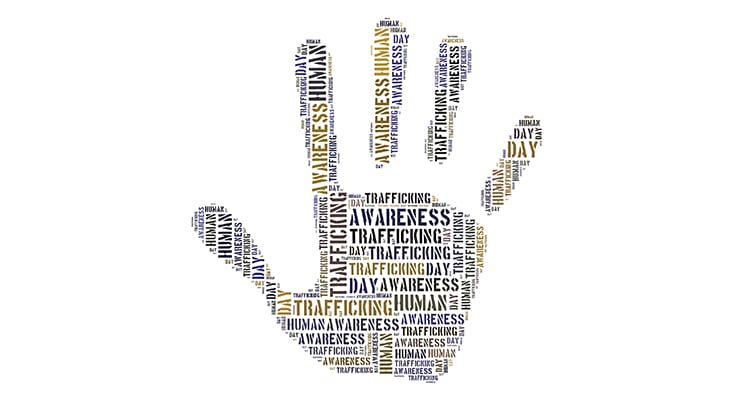How to Recognize the Signs of Human Trafficking
Human trafficking is a rampant global health problem affecting a growing number of children and adults.

Global Health Problem
Human trafficking is a rampant global health problem affecting a growing number of children and adults. Trafficking is identified as a form of slavery and a major, yet often hidden, crime involving the control of victims for the traffickers’ economic gain. Targeting potential victims who appear lost, disenfranchised, or in desperate situations, traffickers are adept at isolating victims from social support systems and creating dependence, limiting victims’ movement to work settings, and hiding the signs of victimization. Human trafficking victims are often lured by promises of lucrative employment, stability, ability to obtain an education, a steady income to send home to support their families, or a loving relationship.
Photo Credit: Kamionsky / iStock / Getty Images Plus

Know the Signs
While the stories of trafficked survivors often include accounts of trying to improve their lives or that of their families, and desires to migrate to areas that promise a better future, these individuals are not always migrants. Although transportation may be a control tactic to keep human trafficking victims in unfamiliar places, the defining characteristic is exploitation for profit, rather than being moved from one region to another. Given the extent of the problem and that trafficked individuals may seek dental treatment, oral health professionals have a responsibility to recognize the signs that may indicate victimization and be prepared to provide appropriate treatment, resources, and referrals.
Photo Credit: MattZ90 / iStock / Getty Images Plus

Labor and Sex Trafficking
Labor trafficking victims are most often recruited through a job offer and represent approximately 11% percent of US victims, while sex trafficking accounts for 82% of victims in the US; of the latter, most are trafficked by their intimate partners. In 2016, an estimated one out of six of the 18,500 runaway children reported to the National Center for Missing and Exploited Children were likely sex trafficking victims. Children are often targeted through social networking and escort websites, and at bus and truck stops, train stations, youth centers, homeless shelters, schools, and malls—often within hours of displacement from their homes. Youth entrapment and enmeshment schemes are frequently used in the sex trafficking of minors and resemble power and control techniques observed in other exploitive relationships, such as intimate partner violence (IPV), in which there are similarities in the victim and perpetrator dynamics.
Photo Credit: microgen / iStock / Getty Images Plus

High Risk Populations
In both child sex trafficking and IPV, the trafficker/perpetrator gains control by isolating victims from outside social support and terrorizing victims through the use of emotional blackmail and/or physical and sexual violence. Glamorizing and normalizing commercial sex are additional ways adolescents are enticed into sex trafficking, often by the trafficker’s use of peers for recruiting. This may include peer recruiters who appear to be living the good life. Pervasive themes in the literature indicate that a female’s age is her greatest vulnerability to being sex trafficked as a minor. Vulnerable populations include children in the child welfare system and foster care, runaways, homeless individuals, those living in impoverished communities seeking work, migrant workers, individuals with limited English skills, those with disabilities, socially marginalized individuals, people rooted in vulnerability to gender inequality situations, and those who identify as lesbian, gay, bisexual, transgender, or intersex.
Photo Credit: Serghei Turcanu / iStock / Getty Images Plus

Unmet Dental Needs
Victims of human trafficking frequently present to medical and dental facilities with a variety of physical health needs, including injuries from violence, head and neck trauma, sexually transmitted diseases (STDs), dental or orofacial conditions, and malnutrition.19,20 Other common presenting factors include substance use and/or addiction, oral lesions associated with STDs, multiple pregnancies, and forced abortions. Physical injuries to trafficked individuals are often inflicted to the head and face, including teeth and jaw fractures and mandibular dislocations; consequently, demand for dental care is one of many common needs of trafficked victims.
Photo Credit: Ildo Frazao / iStock / Getty Images Plus

Help in the Dental Setting
Victims may present for dental services as a result of restricted access to dental hygiene products or deleterious effects on oral health from sex or labor work, as well as for cosmetic purposes. Additionally, a sex trafficker’s interest in seeking cosmetic dental services would most likely stem from a desire to make the victim more attractive to clients. Thus, the responsibility of identification relies on the provider’s ability to recognize the sometimes subtle signs of victimization and follow up with focused questions to assess immediate treatment and referral needs. That said, the role of oral health professionals in assisting victims of human trafficking has not been extensively discussed in the literature. In some cases, oral health professionals may be the first responders in rendering care to trafficked individuals. A survey of US-based survivors of human trafficking shows that while being trafficked, 26.5% were seen by a dentist, along with other health care providers, but few victims were identified by these clinicians.
Photo Credit: enot-poloskun / iStock / Getty Images Plus

Steps to Help
Separating the patient from the third party accompanying him or her to the health visit is a crucial first step in conducting screening questions about human trafficking. A third party’s refusal to allow the patient to be alone with the provider may indicate that he or she is not concerned with obtaining the best care for the patient, but instead fears being divulged as a trafficker. The patient can be asked if he or she requires an interpreter or prefers a male or female clinician. It is also up to the clinician’s judgment to enlist interpreter services if the provider suspects impaired communication is affecting the ability to provide necessary health care. The denial of interpreter services by the individual accompanying the patient may be another red flag indicating victimization. If a patient divulges that he or she is a victim, the oral health professional must establish rapport, acknowledge the presence of trauma symptoms, respect an adult’s decision on whether he or she is ready and able to self-report, and attend to the individual’s immediate needs and safety. Clinicians should not divulge personal addresses or contact information, or attempt to harbor the trafficked person. Unless legally mandated, providers should not contact authorities without consent of an adult trafficking victim; instead, oral health professionals are advised to encourage self-reporting and refer the patient to the appropriate support services.

